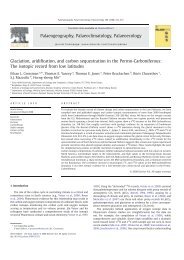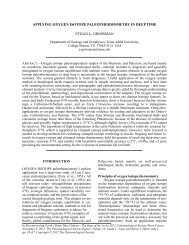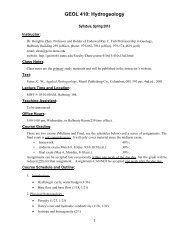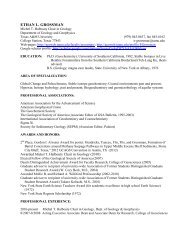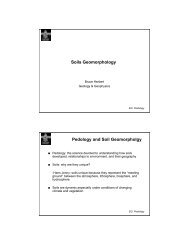An analytical solution for non-Darcian flow in a confined
An analytical solution for non-Darcian flow in a confined
An analytical solution for non-Darcian flow in a confined
Create successful ePaper yourself
Turn your PDF publications into a flip-book with our unique Google optimized e-Paper software.
ADWR 1178 No. of Pages 12, Model 5+<br />
17 July 2007 Disk Used<br />
ARTICLE IN PRESS<br />
8 Z. Wen et al. / Advances <strong>in</strong> Water Resources xxx (2007) xxx–xxx<br />
Fig. 9. Drawdowns <strong>in</strong> the well with wellbore storage with Q =50m 3 /h,<br />
m =50m, k = 0.1(m/h) n , r w = 0.1 m, r c = 1 m, and S = 0.001 <strong>for</strong> the<br />
values of power <strong>in</strong>dex n = 1.1, 1.2, 1.5, and 2.0, respectively.<br />
Fig. 10. Drawdowns <strong>in</strong> the well with wellbore storage with Q =50m 3 /h,<br />
m =50m, n = 1.5, r w = 0.1 m, r c = 1 m, and S = 0.001 <strong>for</strong> the quasi<br />
hydraulic conductivity values k = 0.1, 0.2, 0.5 and 0.8, respectively.<br />
447 A careful check of Sen [26] <strong>in</strong>dicates that the boundary<br />
448 condition can not be<br />
p<br />
trans<strong>for</strong>med <strong>in</strong>to the <strong>for</strong>m <strong>in</strong> terms of<br />
449 the variable g ¼ r= ffiffi t only. There<strong>for</strong>e, the <strong>solution</strong>s as<br />
450 shown <strong>in</strong> Eqs. (9) and (10) of Sen [26] are not only func-<br />
451 tions of variable g but also functions of time t or r, violat-<br />
452 <strong>in</strong>g the requirement of us<strong>in</strong>g the Boltzmann trans<strong>for</strong>m.In<br />
453 order to demonstrate that the drawdown <strong>for</strong> <strong>non</strong>-<strong>Darcian</strong><br />
454 <strong>flow</strong> is not only a function of r 2 /t, we compute the draw-<br />
Fig. 11. Drawdowns <strong>in</strong> the aquifer with wellbore storage with Q =50m 3 /<br />
h, m =50m,k = 0.1(m/h) n , r w = 0.1 m, r c =1m,r = 10 m, and S = 0.001<br />
<strong>for</strong> the values of power <strong>in</strong>dex n = 1.1, 1.2, 1.5 and 2.0, respectively.<br />
Fig. 12. Drawdowns <strong>in</strong> the aquifer (r = 10 m) with wellbore storage with<br />
Q =50m 3 /h, m =50m, n = 1.5, r w = 0.1 m, r c =1m, r = 10 m, and<br />
S = 0.001 <strong>for</strong> the quasi hydraulic conductivity values k = 0.1, 0.2, 0.5, and<br />
0.8, respectively.<br />
UNCORRECTED PROOF<br />
downs <strong>for</strong> four different distances r =10m, 20m, 50m<br />
and 100 m with n = 1.5, Q =50m 3 /s, m =50m, k = 0.1<br />
(m/hr) n and S = 0.001, and present the results <strong>in</strong> Fig. 4.<br />
Differences have been found among the curves of s–r 2 /t<br />
at the four distances. This proves that the drawdown is<br />
<strong>in</strong>deed not only a function of g.<br />
455<br />
456<br />
457<br />
458<br />
459<br />
460<br />
Please cite this article <strong>in</strong> press as: Wen Z et al., <strong>An</strong> <strong>analytical</strong> <strong>solution</strong> <strong>for</strong> <strong>non</strong>-<strong>Darcian</strong> <strong>flow</strong> <strong>in</strong> a conf<strong>in</strong>ed ..., Adv Water Resour<br />
(2007), doi:10.1016/j.advwatres.2007.06.002



